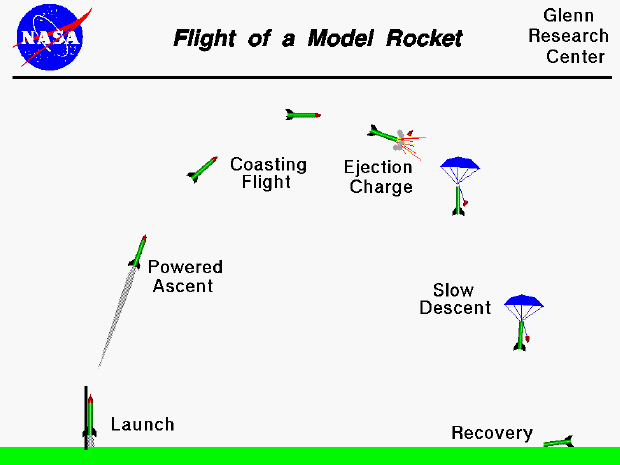

Flying model rockets is a relatively safe and inexpensive way for students to learn the basics of aerodynamic forces and the response of vehicles to external forces. Like an airplane, a model rocket is subjected to the forces of weight, thrust, and aerodynamics during its flight.
On this slide we show the events in the flight of a single stage model rocket. Throughout the flight, the weight of a model rocket is fairly constant; only a small amount of solid propellant is burned relative to the weight of the rest of the rocket. (This is very different from full scale rockets in which the propellant weight is a large portion of the vehicle weight.) At launch, the thrust of the rocket engine is greater than the weight of the rocket and the net force accelerates the rocket away from the pad. Unlike full scale rockets, model rockets rely on aerodynamics for stability. During launch, the velocity is too small to provide sufficient stability, so a launch rail is used. Leaving the pad, the rocket begins a powered ascent. Thrust is still greater than weight, and the aerodynamic forces of lift and drag now act on the rocket. When the rocket runs out of fuel, it enters a coasting flight. The vehicle slows down under the action of the weight and drag since there is no longer any thrust present. The rocket eventually reaches some maximum altitude which you can measure using some simple length and angle measurements and trigonometry. The rocket then begins to fall back to earth under the power of gravity. While the rocket has been coasting, a delay "charge" has been slowly burning in the rocket engine. It produces no thrust, but may produce a small streamer of smoke which makes the rocket more easily visible from the ground. At the end of the delay charge, an ejection charge is ignited which pressurizes the body tube, blows the nose cap off, and deploys the parachute. The rocket then begins a slow descent under parachute to a recovery. The forces at work here are the weight of the vehicle and the drag of the parachute. After recovering the rocket, you can replace the engine and fly again.
Go to...
byTom
Benson
Please send suggestions/corrections to: benson@grc.nasa.gov